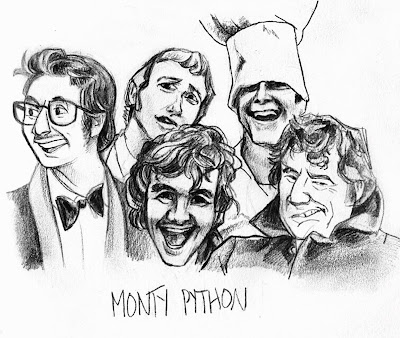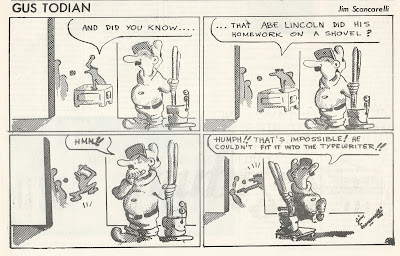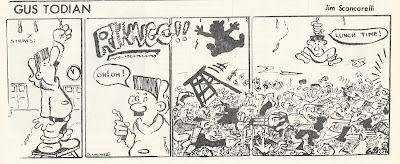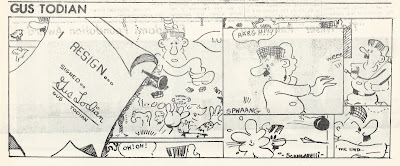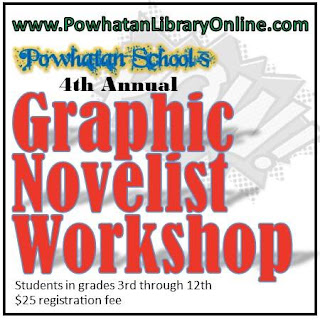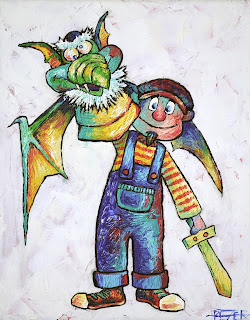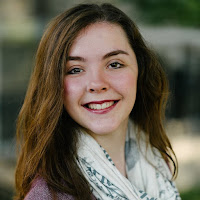
by Mike Rhode
My friend
Bruce Guthrie recently attended a political cartooning event at Georgetown University featuring Matt Wuerker and KAL, which I had to skip due to a scheduling conflict. Afterwards, he made a point of introducing me via email to Alexandra Bowman, the student political cartoonist who organized it. In keeping with our attempts to learn more about local cartoonists, I asked if she would answer our usual interview questions. Alexandra did so directly upon finishing her final exams, and I think you'll all be impressed by her answers.
1. What type of comic work or cartooning do you do?
I am a political cartoonist, children's book illustrator, and fine artist. The menu of galleries on
my website is a bit unwieldy at this point.

I served as the Editorial Political Cartoonist for "The Hoya," the Georgetown University newspaper of record. I left this past fall to start my own political comedy show at Georgetown, "The Hilltop Show"--I create hand-drawn and digital graphics for the show. I was also recently hired as the Editorial Political Cartoonist for Our Daily Planet, a climate news outlet with a readership of 13,000 (my first cartoon was published
here), as well as the Georgetown Review, an independent news source on campus.
I also have illustrated three children's books and do freelance work and commissions. My work has been published by BBC News, BBC Books, Penguin House UK, Puffin Books.
I serve as the Live Political Cartoonist for the Georgetown Institute of Politics for Public Service (GU Politics). My first event was this past September's MSNBC Climate Forum; I created cartoons and life drawings of candidates, including Pete Buttigieg and Bernie Sanders, throughout the two-day event. I also do freelance artwork for GU Politics. All my live cartoons, as well as my past work for "The Hoya" and other political pieces, can be found here.
 2. How do you do it? Traditional pen and ink, computer or a combination?
2. How do you do it? Traditional pen and ink, computer or a combination?
I am partial to drawing/sketching my political cartoons and illustrations in pencil, inking, and coloring with alcohol markers and colored pencils. I'm becoming increasingly fond of coloring via Photoshop, as it's much faster and I don't have to wait three days for the Copic ink to come off my hands.
When making fine art, I enjoy using mechanical pencils for detail work. Oil paint and colored pencils are helpful for creating broad swathes of color.
3. When (within a decade is fine) and where were you born?
I was born in March 2000 in Sierra Vista, AZ. Yeah, I really haven't been around that long.
4. Why are you in Washington now? What neighborhood or area do you live in?
As a current Georgetown undergraduate student, I am currently based in DC. I live in Kennedy Hall at Georgetown, which has only about half the leaks and rodent sightings as the other dorms. When I'm not fending off rat attacks, I live about 30-40 minutes from Washington D.C. in Fairfax, VA.
5. What is your training and/or education in cartooning?

I took AP Studio Art in high school, and took an Oil Painting class last year at Georgetown. I've had a few extracurricular art classes here and there. My mom is an artist: she ensured that I always had access to art supplies and art books, and took me to museums on almost a weekly basis as a kid. I have also spent years teaching myself to draw. Every break from school invites the existential question of "how many coffee table-sized Art-Of-The-Movie books should I bring home?"
6. Who are your influences?
While teaching myself over the years, I have devoured art books and classically-illustrated children's books, particularly animation concept art books and anthropomorphic animal stories. Beatrix Potter, Dr. Seuss, Milt Kahl, Frank Thomas, Ollie Johnston, Byron Howard, Jin Kim, Shiyoon Kim, Cory Loftis, Jim Davis, Christopher Hart, the illustrators of the Geronimo Stilton books (whose pseudonyms on the copyright pages have been tragically unhelpful), and Trina Schart Hyman. From a young age, I have been particularly enchanted by illustrations of anthropomorphic animals, especially those with a semi-realistic tone (e.g. the work of Beatrix Potter, Disney's Robin Hood, Zootopia, Aesop's fables illustrations, etc.).
Beatrix Potter and Jim Davis were my earliest influences. Whenever I draw an animal or a chubby character, its arms and paws/hands are (unintentionally) posed exactly like Garfield's. I drew Garfield all over my notebook and test margins in the fifth and sixth grades. And when I saw "The Hobbit:" when I was 12 (on December 22, 2012; yeah, I know), I became engrossed with Tolkien and Bilbo Baggins. I received a Bilbo Baggins bobblehead for Christmas three days later, and I decided to draw it that evening. I proceeded to cover my seventh and eighth-grade planners with drawings of Bilbo, and that doodle instinct has not since abated.

I've only begun to get into political cartooning recently, but I have long adored the work of the Washington Post's Ann Telnaes, Politico's Matt Wuerker, and The Economist's Kevin Kallaugher. I actually helped plan a
GU Politics/Hilltop Show event this month hosting Mr. Wuerker and Mr. Kallaugher on campus; I delivered the event's opening remarks and introduced the cartoonists.
Vincent Van Gogh, Albrecht Durer, and Leonardo da Vinci are some of the biggest influences of my fine art.
7. If you could, what in your career would you do-over or change?
I don't think I've been drawing professionally long enough to have had any major slip-ups or regrets. I think.
I am, however, at the stage (the "Early Life" section on Wikipedia?) that I will look back on in 5-10 years and wistfully think "If I had only known/done X at that time!" Advice from more experienced cartoonists is always much appreciated!
8. What work are you best-known for?
Live political cartooning at the Climate Forum was a pivotal moment in my artistic "career" (I'm 19, I squirm when I use that word). Since coming to Georgetown, I have immersed myself in political cartooning for multiple publications. I think if you were to ask someone who has a second-degree connection to me (socially or on LinkedIn) what I tend to draw, they'd mention "the girl who draws political cartoons and foxes and John Oliver and had that massive display in the library coffee shop once."

As mentioned, I was also recently hired as the Editorial Political Cartoonist for
Our Daily Planet, a climate news outlet that John Kerry apparently reads every morning.
On a fun note, one of my drawings of the Fourth Doctor and K-9 was published by BBC Books and Puffin Books/Penguin Random House in an international anthology for sale in Barnes and Noble.
9. What work are you most proud of?
I'm particularly proud of my recent political cartoons, as I'm excited to have ventured into a field of art that I believe has more of a tangible positive impact on the world. I believe that political satire is one of the most effective means of reaching those who would not otherwise engage with the news in politics, as young people and the politically uninitiated are much more likely to engage with informational media if it is presented in an entertaining package.
10. What would you like to do or work on in the future?

I would like to be a broadcast journalist, news anchor, or political comedy talk show host. Writing for the latter would be an ideal intermediary position. I really admire how Jake Tapper has been able to tactfully combine his interests in strict news reporting and political cartooning by hosting both "The Lead" and his "State of the Cartoonion" segment.
I would also love to direct films for Pixar.
In the case of either life path, I would like to use my career to create meaningful media and/or entertainment, particularly for young people.
11. What do you do when you're in a rut or have writer's block?
I'm blessed that I rarely have to deal with writer's/artist's block. Keeping a notebook and writing down ideas whenever they occur to me helps keep creative blockage at bay.
Watching a 2-D Disney movie or watching late-night comedy never fails to offer heaps of inspiration.
12. What do you think will be the future of your field?
I hope that illustrators and filmmakers who intend to create meaningful, character-building animated films for children enter the field of animation. I admire how Pete Docter has imbued the films he has worked on/directed (i.e. Wall-E) with his Christian faith.
I believe the future of political cartooning may lie with animated political shows, such as Stephen Colbert's underrated animated series "Our Cartoon President." The show has been more or less panned by critics, but each show is essentially a 30-minute moving political cartoon and deserves credit for being more or less the first of its kind.
13. What local cons do you attend? The Small Press Expo, Awesome Con, or others? Any comments about attending them?
Being a Georgetown student with newfound access to DC has given me a new perspective on the sheer quantity of phenomenal cons available to me. I'm eager to continue learning about new cons to visit, particularly those that focus on film-making and illustration
For a number of years I have attended AwesomeCon, where I have met Wallace Shawn, Cary Elwes, Chris Sarandon, Adam West, Burt Ward, and David Tennant. I met David Tennant while dressed as the Tenth Doctor; I gave him a drawing of Ten meeting Scrooge McDuck, which David said "was the pinnacle of all his work." I continue to share this story with my Uber drivers.
14. What's your favorite thing about DC?
Coming to Georgetown, I was concerned that DC did not have the media and/or entertainment presence of New York or Los Angeles. However, perhaps partially due to my interests changing since arriving on campus a year and a half ago, I'm realizing that DC's political focus makes it a media hotspot particularly well-suited to my own interest in politics. DC being where the action is in terms of current global chaos is also a plus.
15. Least favorite?
See previous sentence.
16. What monument or museum do you like to take visitors to?
#ripnewseum.
17. How about a favorite local restaurant?
My favorite restaurant of all time is
Filomena in Georgetown. I am comforted knowing that my culinary tastes have been validated by Bono and Harrison Ford.
 18. Do you have a website or blog?
18. Do you have a website or blog?
My work can be found on
alexandrabowmanart.com and on Instagram (
@alexandrabowmanart). I also tweet about illustration and current events under the handle
@scripta_bene. I have a Facebook page for my work, which sends me notifications two or three times daily saying "Your followers have not seen a post from you in months." It's linked
here if you're still interested.






















